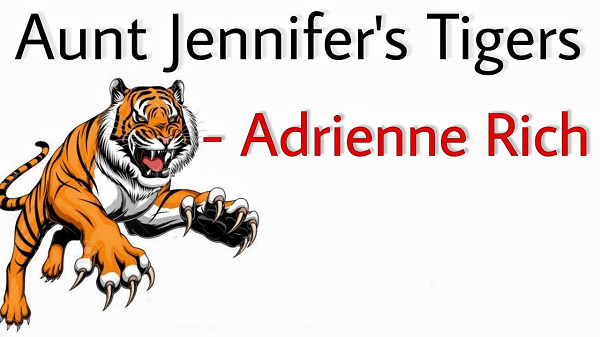Aunt Jennifer's Tigers Summary Class 12 EnglishIntroductionThe author of the poem Aunt Jennifer's Tigers is Adrienne Rich, one of the key pioneers in the feminist movement of the 20th century. As suggested by the poem's title, it is about an old married lady who is trapped in a male-dominated marriage and how her art enables her to flee her unhappy union. The poem has three sections, each of which has four lines. The poet describes the tigers' brave, courageous, and free character in the opening line. In the second verse, the poet describes Aunt Jennifer, the artist, as being the exact opposite of her work-trapped, fearful, and pain-bearing. The final verse contrasts Aunt Jennifer's life as an artist with that of her work. 
The poet comes to the conclusion that although Aunt Jennifer has suffered throughout her life as a result of her failed marriage and will continue to suffer after death as well, her work will remain courageous, proud, and eternal. It becomes clear that the poet is alluding to the influence of art as we read this poem over and over. According to the poet, ladies might find happiness by utilizing their gifts elsewhere. Art has no bounds or restrictions, unlike people. In essence, the poet wants to inspire women to use their artistic expression to speak out against their servitude. About the Author"Aunt Jennifer's Tigers" is a 1951 poem by American poet Adrienne Rich (1929-2012), which was included in her debut collection of poems, A Change of World, which was released while the prodigious Rich was only in her early twenties. 
Rich was well-known for her feminist writings in addition to her poetry, and this information is important for analyzing the poem "Aunt Jennifer's Tigers," in which the speaker contrasts her aunt's meek, oppressive life and marriage with the embroidery she made of tigers that prance proudly and fearlessly. The Theme of the PoemThe poem "Aunt Jennifer's Tigers" from the Class 12 English Flamingo textbook explores women's struggle for autonomy and expression in a patriarchal society. The aunt of the narrator, Jennifer, and the tiger design she embroidered on a tapestry are depicted in the poem. The tiger symbol is utilized to reflect Aunt Jennifer's aggressive attitude as well as her quest for independence and self-expression. In the poem, women are similarly held back and constrained by societal norms and expectations, particularly those related to gender roles and norms. Though Aunt Jennifer finds it difficult to express herself in daily life fully, the speaker implies that her embroidery art is the only medium through which she is able to do so. Aunt Jennifer's Tigers SummaryThe author introduces the poem's protagonist, Aunt Jennifer, at the beginning. She embroiders tigers for a wall hanging or other fancy item of clothing. She is married. In this photo, the tigers can be seen prancing. They are tigers of a yellowish-brown colour set against the green of the forest, and they appear to be topaz stones when set against the background of the forest. They contrast Aunt Jennifer's personality, which her husband's tyranny has severely harmed. The tigers are brave and do not fear the guys who are standing beneath the forest's trees. Having the courage and freedom to be oneself is a depiction of Aunt Jennifer's biggest goal. The forest's males are a metaphor for the limitations her husband has placed on her. 
The carefree and naive attitude Aunt Jennifer had prior to marriage, which would have made her courteous and self-assured, is something she misses. It is described by the poet's use of the phrase "sleek, chivalric certainty" to describe the movement of the tigers. Aunt Jennifer is frail and twitchy from living in constant fear and pain. Even performing her everyday tasks with calm and serenity is beyond her. The poet utilizes the metaphor of "fluttering fingers" to express her dread because she is unable to hold the yarn she is knitting. When she is embroidering, she finds it challenging to pull the ivory needle. The prolonged exposure to being instructed what to do and what not to do has Aunt Jennifer in a state of complete shock. Everything associated with the marriage appears like a weight and tends to remind her of the bondage because the experience of the marriage has been so harsh. She discovers that her wedding band is too heavy to handle as a result. It represents the result of the years' worth of hardship and emotional struggle she has endured. It is difficult to free oneself from the bondage that Aunt Jennifer is experiencing. Only when she passes away may she be liberated from it. But according to the poet, even after she passes away, the ring she is wearing will serve as a constant reminder of all the challenges and unpleasant aspects of her marriage. As a result, the poet speculates that her situation may not end even after she passes away. The poet is using Aunt Jennifer's unhappy marriage experiences to make her point. Despite all of this, she harbored a suppressed longing for freedom from shackles and servitude. She has drawn a portrait of tigers to symbolize this yearning, which is a different aspect of her nature. ConclusionThis poem conveys a very powerful message in terms of the struggles women face in a predominately male culture and the negative effects it has on women's lives, particularly married women's lives. The poet explores a current and important topic that still dominates debates today via her creativity and talent. In the poem, the ladies are encouraged to show bravery by releasing their chains and adopting the Tigers' audacity and fearlessness.
Next TopicThe Last Lesson Summary Class 12 English
|
 For Videos Join Our Youtube Channel: Join Now
For Videos Join Our Youtube Channel: Join Now
Feedback
- Send your Feedback to [email protected]
Help Others, Please Share









